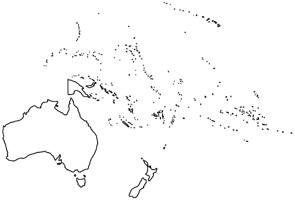
|
The Society of Folk Dance Historians (SFDH) Oceania
[
Home |
About |
Encyclopedia | CLICK AN IMAGE TO ENLARGE |

|
BACKGROUND
Information: A region.
Oceania is a geographic region that includes Australasia, Melanesia, Micronesia, and Polynesia. Spanning the Eastern and Western Hemispheres, Oceania has a land area of 3,291,903 square miles and a population of over 41 million. When compared to continents, the region of Oceania is the smallest in land area and the second smallest in population after Antarctica.
The first settlers of Australia, New Guinea, and the large islands just to the east arrived more than 60,000 years ago. Oceania was first explored by Europeans from the 16th century onward. Portuguese navigators, between 1512 and 1526, reached the Tanimbar Islands, some of the Caroline Islands, and west Papua New Guinea. On his first voyage in the 18th century, James Cook, who later arrived at the highly developed Hawai'ian Islands, went to Tahiti and followed the east coast of Australia for the first time.
The arrival of European settlers in subsequent centuries resulted in a significant alteration in the social and political landscape of Oceania. In more contemporary times there has been increasing discussion on national flags and a desire by some Oceanians to display their distinguishable and individualistic identity.
Location: The name Oceania establishes the Pacific Ocean as the defining characteristic of the region.
Language: Native languages of Oceania fall into three major geographic groups:
- The large Austronesian language family, with such languages as Malay (Indonesian), and Oceanic languages such as Gilbertese, Fijian, Māori or Hawai'ian.
- The Aboriginal Australian languages, including the large Pama–Nyungan family.
- The Papuan languages of New Guinea and neighboring islands, including the large Trans–New Guinea family.
Colonial languages include English in Australia, New Zealand, Hawai'i, and many other territories; French in New Caledonia, French Polynesia, Wallis and Futuna, and Vanuatu, Japanese in the Bonin Islands, Spanish on Galápagos Islands and Easter Island. There are also Creoles formed from the interaction of Malay or the colonial languages with indigenous languages, such as Tok Pisin, Bislama, Chavacano, various Malay trade and creole languages, Hawai'ian Pidgin, Norfuk, and Pitkern. Contact between Austronesian and Papuan resulted in several instances in mixed languages such as Maisin.
Religion: Predominantly Christianity
This page © 2018 by Ron Houston.
Please do not copy any part of this page without including this copyright notice.
Please do not copy small portions out of context.
Please do not copy large portions without permission from Ron Houston.